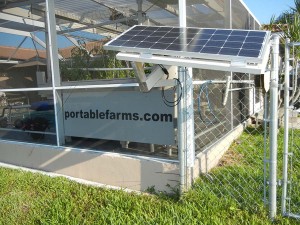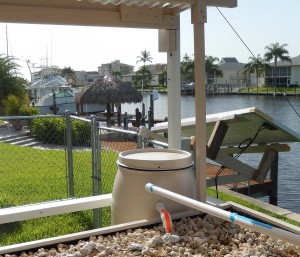Solar Aquaponics – The Future of Growing
– by Colle and Phyllis Davis
Heat and light are the heart-and-soul of aquaponics after the water, plants and fish are in place.
Here we have to make a couple of assumptions about your current or planned solar powered aquaponics system: 1) the constant aeration pump and the circulation pump requirements have already been planned for and 2) calibrated against the output of the system.
Now let’s bring the other two CEA (Controlled Environment Agriculture) elements to your aquaponics system by adding:
- Grow lights – not expensive, easily available and need more power than a single deep cycle battery can supply
- Heat for the fish tank – less expensive, easy to install and, yes that second battery is necessary.
The grow lights require a converter to up the voltage from 12vdc to 110 or 220vac and this step takes power and additional components. (There are 12v florescent lights, but they have a long way to go to be effective.) You may already use a converter to run you water pump and if so make sure you upgrade to enough watts to handle all of the current draw on your system.
 The rule of thumb (green or not) is that plants need to have full spectrum lighting or special growing lights in a density sufficient to grow and be healthy. We have successfully used the guideline of one, four tube 4’ T8 Super-sunlight fixture per 2m or 6’ of grow tray length. These fixtures, including bulbs, are less than US$80 almost everywhere in the world. The 32watt tubes times 4 tubes means each fixture requires 128watts of power per hour for up to 4 hours per day. (Indoor growing has a very different time frame and cost.) To translate this to power usage: There needs to be 128watts x hours of use = watts per hour requirements from your solar electrical system. We started with one deep cycle marine battery and found very quickly that a second matching battery was needed to operate the grow lights for three hours per day over the six months of short days.
The rule of thumb (green or not) is that plants need to have full spectrum lighting or special growing lights in a density sufficient to grow and be healthy. We have successfully used the guideline of one, four tube 4’ T8 Super-sunlight fixture per 2m or 6’ of grow tray length. These fixtures, including bulbs, are less than US$80 almost everywhere in the world. The 32watt tubes times 4 tubes means each fixture requires 128watts of power per hour for up to 4 hours per day. (Indoor growing has a very different time frame and cost.) To translate this to power usage: There needs to be 128watts x hours of use = watts per hour requirements from your solar electrical system. We started with one deep cycle marine battery and found very quickly that a second matching battery was needed to operate the grow lights for three hours per day over the six months of short days.
Here are the components you will need (assuming you are using an existing solar electrical system) to ‘go solar’ with your grow lights:
- A second matching battery
- An 800watt converter – 12vdc to 110 or 220vac (this is for one grow light fixture)
- One Super-sunlight T8 four tube fixture or similar per 2m (6’) of grow tray length
- Mounting hardware for above the trellises
These will cost in the range of US$300 to US$400.
Now for the heating system:
In most aquaponics systems, the fish tank is or can be plastic or a heavy rubberized food-grade material. (Please do not use galvanized steel because the zinc will leach into the water and is harmful to both fish and plants.) With a fish tank made of these materials you can add a thermostatically controlled heating system for under US$100, extra battery not included. Most warm water, fresh water fish do very well at between 75 and 80° F (25 to 27° C).
 Using a 12vdc heating element and a thermostat to keep the water in the fish tank within a desired range will contribute both to your production and your peace of mind. In colder climates the fish tank needs to be heavily insulated, especially the bottom and top. Placing the heating element near the aerators also helps to distribute the heat within the tank.
Using a 12vdc heating element and a thermostat to keep the water in the fish tank within a desired range will contribute both to your production and your peace of mind. In colder climates the fish tank needs to be heavily insulated, especially the bottom and top. Placing the heating element near the aerators also helps to distribute the heat within the tank.
Here is the list of components to ‘go solar’ with the fish tank heater:
- 300 watt 12vdc heater element
- Thermostat/relay to control the heating element
- Adapter to mount heating element into side of fish tank (may not be necessary)
Yes, that is the list of components. Please note the adaptor, if needed, is a multipart component that may require some slight modifications to work in your situation.
The heating element is mounted in a hole you have cut in the side of the fish tank. (please drain the tank to below the hole FIRST.) The components for the adaptor are available at hardware and home centers in the plumbing section.
 The thermostat is mounted near or on the top of outside of the tank and the sensor is fastened to the OUTSIDE of the tank about half way up the side and covered with insulating material. The sensor does not need to be in the water and fastening it to the outside of the tank reduces its exposure to the water and fish.
The thermostat is mounted near or on the top of outside of the tank and the sensor is fastened to the OUTSIDE of the tank about half way up the side and covered with insulating material. The sensor does not need to be in the water and fastening it to the outside of the tank reduces its exposure to the water and fish.
Here’s information about the wiring: The positive (+) wiring is from the battery bank (+) terminal to the thermostat then to the heating element. The negative or neutral wire goes from the battery bank (-) terminal to the heating element.
With the lights and/or the heating element(s) in place your solar electric system may or may not carry the load. Keep a close eye on its performance. Suggestion: The solar panel needs to be at least a 100w panel and the MPPT (charge controller) able to handle 20 amp loads. Upgrading either component will increase the cost. If you have not yet purchased your solar panels, opt for a minimum of 100watts and better 200watts.
A solar power system with a 200w panel, an MPPT that can handle 20amps and two deep cycle batteries will normally support a properly constructed and insulated single fish tank system including the grow lights even in extreme climates.
Send us pictures of your installations so we can brag on you


4 pings